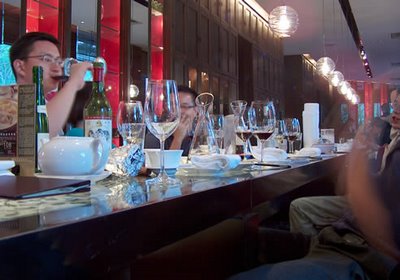Sniff my wine...
 Take a good sniff of your wine. We get a lot of information from our noses in tasting. In fact, the nose is involved both in sniffing the wine, and also when the wine is in the mouth, at which point you’ll be receiving information from both your tongue (taste buds) and the olfactory receptors in the back of your nose – a sort of smell known by scientists as retronasal olfaction (normal smell as you sniff is termed orthonasal olfaction).
Take a good sniff of your wine. We get a lot of information from our noses in tasting. In fact, the nose is involved both in sniffing the wine, and also when the wine is in the mouth, at which point you’ll be receiving information from both your tongue (taste buds) and the olfactory receptors in the back of your nose – a sort of smell known by scientists as retronasal olfaction (normal smell as you sniff is termed orthonasal olfaction).We have an impoverished language for taste and smells, and this makes the next phase difficult. This is the process of beginning to put words to our experience as we assess the wine. Why are words necessary? Because it’s only as we begin to think of descriptors for our sensory experience that we are able to make sense of it. These words act as pegs on which we hang our impressions, or, to use another metaphor, they are like drawers in a desk in which we file our impressions away. Not only do words enable us to structure our perceptions in such a way that we can write them down, they also focus the tasting event in such a way that we can get more out of the wine.
This all sounds a bit theoretical and complicated. What I’m saying is that developing a language for wine is a vital step in being able to appreciate it. More on this later. For now, let’s stay practical, and think about some of the smells you might experience.
Dr Ann Noble, emeritus professor at the University of California, Davis, is famous for developing a wine aroma wheel. This is a circular dartboard-like chart, broken into rings and segments, which groups all the sorts of aromas you might experience in smelling wines into similar categories. This aroma wheel is a useful tool for developing a vocabulary for describe wines with. It begins with broad category terms, such as ‘fruity’, or ‘earthy’, and then offers a range of more specific descriptors for each category.
But let’s not get too carried away with aroma wheels. While they are very useful for analytical tasting, their very nature carries with it a danger. The problem with these sorts of winetasting approaches is that we become ‘reductionist’, breaking the wine down into its component parts. In this sensory dissection, it is very easy to lose sight of the whole. Wine is more than just a sum of its parts.
Let me try to use a rather stretched metaphor to explain this. Think of one of these reductionist descriptions of a wine as a CV. There’s a world of difference between reading a CV – which gives factually correct and useful information about a person – and meeting the person themselves. If I were to ask you to describe a good friend of yours, you could send me their CV, but this wouldn’t tell me what they are really like. It would be better for me to meet the person, but if I couldn’t do that, then you’d be better off writing a few paragraphs about what the person is like, than jotting down facts about them in CV-like fashion.
When we come to try to write down our impressions of a wine, it’s important not to get too carried away by just listing descriptors. Yes, I’m impressed that you’ve spotted three different fruits, two distinct earthy components, another two different spices and that you’ve nailed the way the tannins are showing. But what does the wine taste like? What is the overall impression? Don’t lose sight of the whole as you look at the bits. That’s what I’m trying to say.
Before we put the wine in our mouths, we’ll dwell a little on the ‘nose’, which is the term used in the trade to describe what the wine smells like. Is it aromatic (particularly smelly) or muted (not showing a great deal)? Is it predominantly showing fruity aromas, or are there what are known as ‘secondary’ aromas, such as earth and spice? Is there any evidence of vanilla or coconut or toast, which could indicate some oak? Is there some greenness (herby or grassy aromas)? Is it sweet or savoury? Is it complex or simple? Is it nice? Is it weird and a bit funky? These are just examples of the sorts of questions you can ask yourself which will help you tie down some of your sensations so that you can put them into words.


2 Comments:
There's a winery website from CA, Turning Leaf, that has an online aroma wheel in which you can see what a "normal" varietal should smell like. Then you can smell/taste you wine of choice and see how you match up to the average. The aroma wheel in general has greatly helped my vocabulary, which jogs my memory, which is linked to smell, and my wine appreciation in general. This is a great way to utilize the wheel. If you have a laptop, it's handy to set it in you kitchen/dining room with the site up while you quaff:
http://www.turningleaf.com/LinkedFiles/Tools/AROMA.htm
I need to know which service is the best from the ones listed on the site? Resume Examples For Experienced
Post a Comment
Subscribe to Post Comments [Atom]
<< Home